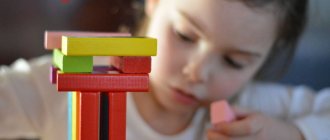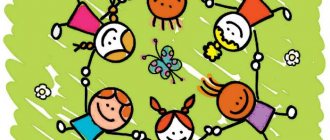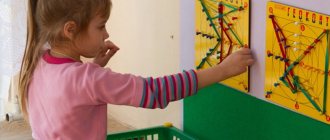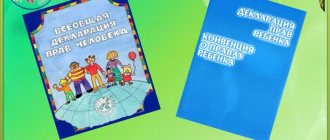The article presents general recommendations and time-tested practical advice on how to develop thinking in a child.
Thinking reflects a person’s ability to understand the world around him, think, accumulate knowledge, discover new laws, solve emerging problems and tasks, create and transform.
The foundation of thinking is laid in early childhood, when the child first masters visual-actional thinking (it is basic until about 5 years old), then visual-figurative thinking (it prevails until about 6-6.5 years old) and verbal-logical thinking (it is formed around the age of 6-6.5 years). 6 years old, predominates from 7-8 years old and remains dominant in most adults). Visual and effective thinking allows a child to explore the world through interaction with objects.
Visual-figurative thinking makes it possible to imagine objects, even if they are not available, and operates with these images and ideas (remember how Malvina asked Pinocchio to imagine that he had an apple in his pocket?). You can read more about the development of visual thinking on our blog, in the article “Development of Visual Thinking”.
Verbal-logical thinking allows the child to handle words that denote phenomena or objects. It grows out of the figurative and helps to analyze and synthesize, reason, draw conclusions, classify, infer, compare, highlight the main and secondary.
Logical thinking in preschool children goes through some stages of development:
- Mastering the ability to compare, generalize, divide into groups, and classify.
- Modeling.
- Ability to work with algorithms and create algorithms.
- Combinatorics.
- Solving problems on intelligence and the rudiments of using scientific information.
- Clarification of the meaning inherent in fairy tales, proverbs, riddles.
- Solving puzzles, watercress crosses.
What is thinking
Every day we make many decisions: how to get from point A to point B faster, what to give a friend for his birthday, how to solve a difficult problem at school or in everyday life.
And although the world is full of uncertainties, the way we reason still partially influences the outcome. Thinking is when we learn something: we systematize and analyze information, build connections, highlight what is important, discard what is unnecessary and draw conclusions.
How it works
Thinking “does” the brain, and the result is called thought.
To understand how to develop thinking, it is important to clarify: thinking itself can be different - it all depends on what kind of work our brain does.
| Visually effective - this is when we make a decision right within a situation that is constantly changing. Chess and puzzles are a great example. A very useful skill for a world that changes every day - and what’s more, sometimes several times a day. Visual-figurative means imagining some situation or image, but not actually doing anything with it with your hands. For example, to see something familiar in a random passer-by and think about what it is connected with: maybe he looks like a neighbor or a famous actor (or is he the same actor)? Verbal-logical - we use this type of thinking when we group objects by characteristics (smartphone, fitness bracelet, wireless speaker - gadgets), affirm or deny something (the weather is good outside, the sun is shining and it’s warm / the weather is terrible outside, the sun is shining and it is very hot) or we draw conclusions based on judgments (mom said that she is busy with work in the evening - that means she will not come to the parent-teacher meeting). Theoretical thinking is a favorite pastime of scientists! When they conduct experiments, they isolate and analyze different characteristics of phenomena. All this helps to mentally change the object and study it in detail. For example, you need to decide what is better to take for a snack at school: a banana or an apple. Let's analyze: a banana is soft and can ruin notebooks in a backpack, an apple is hard and takes up less space. The choice is obvious! Practical thinking is to set a goal to learn English and come up with a plan for this task so that there is motivation to continue. Creative thinking is when we solve simple problems out of the box: we use imagination, systematize and analyze. For example, you need to figure out how not to worry at a family photo shoot. You can invite parents to portray different animals and communicate with each other in their languages. Then the shots will come out with smiles, and the process will be fun. |
Working with patterns
The pattern can be hidden in drawings, between numbers, letters, or any elements of a series.
To learn how to correctly find a pattern, we follow the following algorithm:
- We look carefully at a number of numbers, figures, animals, objects.
- Let's try to guess what the pattern is based on - what rule the elements are arranged according to.
- We are trying to determine the type of pattern.
- We test our assumptions one by one to see which rule holds.
- Having made sure that the “intended” rule is observed, we will be able to accurately name the next elements of the series.
Examples of patterns with numbers:
2, 5, 8, 11, 13, …
3, 4, 7, 8, 11, 12, …
99, 10, 88, 20, 77, …
4, 16, 5, 25, 6, …
Coloring books with logical patterns are perfect for children aged 5-9 years.
Why develop on your own if there is a school?
School programs develop thinking, but working with your child at home is no less important. And here’s why: lessons at school give children new knowledge, but it’s homework that helps them consolidate and assimilate it—it’s the same story with exercises to develop thinking.
In addition, at home the child feels more comfortable - with his family it is easier for him to share thoughts, make mistakes and try again. Here are some more reasons in favor of developing your thinking:
- Antistress. With developed thinking, it is easier to cope with emotions and solve difficult situations.
- Save time. Children with developed thinking know how to set priorities and strive to manage their time themselves.
- Creativity. Non-standard ideas and new solutions are in demand both at school and beyond. Developed thinking helps to see where the border of stereotypes and norms lies - and when it is appropriate to go beyond them.
- Social implementation. Underdeveloped thinking limits potential. To become a physicist, in addition to good grades at school, you also need diligence and motivation to enter a university and complete your studies. It’s the same with work - specialists with flexible minds have more opportunities compared to those who only have knowledge and experience, but do not have the necessary skills.
Exercise 3. Puzzles
Solving puzzles helps you think outside the box and creatively. Teaches the child to analyze.
Puzzles may contain images, letters, numbers, commas, fractions, placed in very different orders. Let's try to solve some simple puzzles together.
- On the first one we see the syllable “BA” and “barrel”. Let's connect: BA + Barrel = Butterfly.
- On the second, the principle is the same: Ram + KA = Steering wheel.
- The third one is more difficult. A cancer is drawn, and next to it is “a = y”. This means that in the word cancer, the letter “a” needs to be replaced with the letter “u”, we get “hand”. To this we add one more “a”: hand + a = hand.
- The fourth rebus with a comma. Since the first letter is “A”, the guess word begins with it. Next we see “fist”, after the picture there is a comma, which means you need to subtract the last letter from the word “fist”. Let's get "kula". Now let's put it all together: A + kula = shark.
- The fifth rebus is difficult only at first glance. You need to remove the letter “i” from the word “saw”, and read the word “cat” backwards. As a result, we get: pla + tok = scarf.
- The sixth, completely letter puzzle. Everything is clear with the first and last letters, but what about the middle? We see the letter “o” drawn in the letter “t”, so let’s say “in t o”. We connect: A + WTO + P = AUTHOR.
Have you practiced? Now try to solve the puzzle yourself.
How to develop the thinking of younger schoolchildren
Schoolchildren from grades 1 to 3 are often restless. They live “here and now” and do not yet know how to think logically. Therefore, the key to their development is the gaming format. No amount of motivation and “what you will become when you grow up” work here. Only a game can truly captivate a child.
It is difficult (and even impossible) for children at this age to simply learn something. Therefore, their training should not feel like training. Multiple repetitions, an interesting plot, a bright picture - this is what will attract attention and give results. The more varied the games, the longer it will be possible to maintain the child’s interest. Let's look at five techniques for developing the thinking of younger schoolchildren.
Sort the pictures into groups
Print out a set of pictures depicting simple objects from different areas and invite your child to look at them and sort them into groups. For example: kitchenware, clothes, gadgets, cats, fruits.
By separating some objects from others, the child learns to see what is common and what is different - thereby developing verbal and logical thinking by grouping objects according to characteristics.
Assemble the constructor
Invite your child to make different figures from the construction set - including those that are not in the instructions. The more details, the better.
In the process of selecting figures without instructions, the child learns to make mistakes and try again and develops visual and effective thinking.
So that the child does not get bored with the construction set and explores the world with curiosity, he needs to be inspired to do this. Psychologist and Skysmart expert Ekaterina Murashova will tell you how to do this in the free course “Study without Tears.” During the course we will discuss how modern parents can avoid going crazy by constantly monitoring their children and what can be done to kindle a thirst for knowledge in schoolchildren.
Note the common feature
List words from the same category and ask your child to name one word that unites them. For example:
- cucumber, broccoli, zucchini, radish - vegetables;
- fly agaric, boletus, chanterelle - mushrooms;
- birch, oak, pine - trees.
When a child looks for commonality between different objects, he learns to visualize and analyze their properties and develops visual-figurative thinking through active imagination and processing of past experience.
Play "Words in Reverse"
Name the word and ask your child to find the word with the opposite meaning. You can use different parts of speech:
- nouns (courage - cowardice);
- adjectives (funny - sad);
- verbs (opened - closed).
By choosing an antonym, the child learns to identify opposite signs when other components coincide - through analysis and ingenuity, verbal and logical thinking develops.
Play Guessing Game
Name the different parts of one object and ask your child to guess which object you have guessed. For example:
- numbers, hands - hours;
- ears, tail, trunk - elephant;
- letters, pictures, paper - book.
You can complicate the task: in addition to the parts, also name the characteristics of the object. For example: small, prickly, lives in the forest - a hedgehog.
When a child connects different parts into a whole, he learns to draw imaginary pictures - excellent training for improving verbal and logical thinking.
Development of logic at 6-7 years old
If parents and educators have already taken the first steps in this direction, the child should be able to perform simple logical operations. The simplest of these is comparison.
If at 5 years old a child is offered pairs of objects, then by 6-7 years old he will be able to cope with a large number of objects:
- arrange them in ascending or descending order of size;
- find the largest or smallest of all;
- distribute into groups.
The search for common properties becomes more difficult. At 5-6 years old, preschoolers operate with general concepts such as shape and color. By age 7, more complex classifications based on less obvious characteristics become available.
To develop abilities, games and tasks should become more difficult gradually. It is important that the child is able to complete the task, but it should not be too easy. Otherwise, interest will disappear and motivation will disappear.
How to develop the thinking of middle school students
Draw emotions on the face
Invite your child to draw faces with different emotions. You can name the emotions yourself or ask your child to remember different situations during the day and draw what he felt at those moments.
By drawing sad, happy and angry faces, the child learns to recognize external signals of emotions - which just helps strengthen theoretical thinking and, along with it, emotional intelligence. This happens due to the fact that the child analyzes his feelings and the reactions of other people.
Make up a story
Make up a story with your child. Start with a simple sentence, for example: “Once upon a time there was a cat...”. Let the child continue and say the next sentence, and so on in turns. Try to develop the story according to all the rules of drama, with a plot, climax and conclusion.
By choosing to continue the story, the child learns to boldly voice his fantasies. He develops creative and systematic thinking by consistently articulating his ideas while maintaining the overall meaning.
Play Fact or Fiction
Come up with a sentence with a realistic meaning (mom is preparing dinner) and ask your child whether this is true or fiction. Then say something unrealistic (the book goes home) and ask the same question. Invite your child to tell you true and false sentences.
This is how the child learns to compare reality and fantasy. Thanks to this, verbal-logical thinking develops through the analysis of words and sentences.
Play "Unreal Action"
Take any object and ask your child to imitate an action that we usually do not do with this object: play a mop like a guitar, carry a ball on his head like a crown. Guess what the child is portraying, ask him clarifying questions.
By figuring out how to depict an unusual action with a certain object, the child learns to implement non-standard ideas. At this moment, his flexible mind, together with an active imagination, develops visual-figurative and verbal-logical thinking.
Draw a mind map
Write any word or idea in the center of the sheet. For example, a city. Draw several arrows from it and mark what is in the city: houses, people, roads. Next, draw arrows from each word and determine the categories: what kind of houses there are (schools, residential buildings, factories, shops), what kind of people there are (adults and children, men and women). On the following arrows, mark what is in these houses (classrooms in schools, counters and fitting rooms in stores), what the townspeople do (walk, work). Continue down to the smallest details.
This exercise teaches you to see the whole, its parts and patterns. It gives a positive charge to creative and systematic thinking due to the work of both hemispheres of the brain.
Exercise 8. Instructions
We are surrounded by a variety of objects. We use them. Sometimes we don’t pay any attention to the instructions that come with these items. And it also happens that there are simply no instructions for some very necessary items. Let's correct this misunderstanding! We'll write the instructions ourselves.
Let's take a comb for example. Yes, yes, an ordinary comb! This is what Alexandra and I did.
So, instructions for using the comb.
- A comb is a device made of plastic for making hair smooth and silky.
- A comb should be used for excessive shaggy and curly hair.
- To start combing, go to the comb and carefully take it in your hand.
- Stand in front of the mirror, smile, bring the comb to the roots of your hair.
- Now slowly move the comb down towards the ends of your hair.
- If there are obstacles in the form of knots on the way of the comb, then run the comb over them several times with gentle pressure, while you may cry out slightly.
- Each strand of hair must be processed with a comb.
- Combing can be considered complete when the comb does not encounter a single knot on its way.
- After finishing combing, you need to rinse the comb with water and place it in a specially designated place.
- If a tooth of a comb breaks off, you need to throw it in the trash.
- If all the teeth of the comb have broken off, send it after the tooth.
Try writing instructions for a saucepan, or slippers, or a glasses case. It will be interesting!
How to develop teenagers' thinking
Make a list
Invite your teenager to make a list (checklist) of something important for the whole family or specifically for him: a list of desired gifts, purchases, movies to watch. Then discuss how lists are useful and how he can use them in his studies.
By making a list, a teenager learns to systematize his thoughts, desires, plans - thereby developing practical and systematic thinking by giving form to what was previously only in his head.
Name the differences
Ask about the differences between a ship and a boat, grass and a lawn, a story and a poem, an elephant and a rhinoceros, a still life and a portrait.
When a teenager notices the differences between similar objects, he uses verbal-logical thinking: analyzes the characteristics, distinguishes the main from the secondary, remembers his past experiences.
Come up with a name for the item
Show photographs of gadgets and objects that the teenager has not yet seen: it could be something ultra-modern (a posture sensor) or, on the contrary, something long forgotten (a landline phone with a spring). Offer to come up with a name and describe the functionality of these items.
In this exercise, the teenager learns to express his thoughts boldly and refuse boring and inappropriate ideas. As a result, it helps develop creative thinking by creating new combinations of words.
Play “Create a Scenario”
Show a photo of an ambiguous situation (a dog stuck in a vase) and ask them to guess what happened before that moment.
At the moment of creating his story, the teenager analyzes the situation and sees it more comprehensively - thereby developing creative thinking by expressing his hypotheses and fantasies.
Play Strange Questions
Ask your teen strange and unexpected questions. For example:
- Which is better: apple or melon?
- Which is softer: a hand or a foot?
- What is the use of a giraffe?
The answer must have at least three arguments.
When a teenager answers non-standard questions, he thinks in a state of uncertainty and strengthens verbal-logical thinking - the same one that scientists use.
What advantages does advanced logic provide?
Underdevelopment of thinking is a pressing problem of the present time. It has many negative consequences. The lack of development of the ability to think logically leads to the fact that an adult is unable to:
- think systematically;
- establish cause-and-effect relationships;
- resist manipulation;
- draw the right conclusions;
- argue your point of view;
- refute incorrect statements.
Therefore, practicing logic is an effective way to develop intelligence. This is an investment in the child’s future, where he will be able to think outside the box and go beyond the mold. Regular mental training is a useful habit, because new neural connections need to be formed throughout life.
Analogies and Antonyms
Analogies help to update your vocabulary and find logical connections between words:
- the fork is for eating, and the knife is for…(cutting);
- boots are shoes, and shorts are...(clothing);
- It’s cold in winter, and ... (warm) in summer, etc.
Antonyms:
- thick – thin;
- cold - warm;
- harmful - useful;
- evil - good, etc.
These words and phrases are given as an example; you can come up with something of your own, but you need to select them depending on the child’s individual level of knowledge.







